Simple banana smoothie recipes are great, but wait till you try this banana-almond butter smoothie! I started adding nut butters to my son’s smoothies, and now I’m getting addicted to them.
If you never tried adding almond butter, or peanut butter or other nut butter to a smoothie, you are in for a treat!
The banana-peanut butter smoothie combination may be the most popular variation of this recipe, but don’t stop there. Hazelnut, macadamia, cashew butter, tahini, sunflower, pumpkin, etc. – adding any of this will make your smoothie deliciously rich, creamy and distinctly buttery.
Plus, the fats in these butters will help with absorption of nutrients, and slow down the release of the fruit sugar into your bloodstream (great for people with high blood-sugar level issues).
They will also increase calories in the smoothie – something I’m looking for when making smoothies for my very active nine-year-old son. He is not a big eater in the morning, so a smoothie with nut butter, with some oats, is a good option. (If you are trying to lose weight, make sure you don’t drink too much of these rich smoothies, or cut back some in other areas.)
You may simply buy nut butter for your smoothies – and if you do – be sure to check the label before purchasing. Not all commercially made nut butters contain healthful ingredients. Many brands contain only ground-up nuts, but some contain added salt and sugar. Some use partially hydrogenated oil—a source of unhealthy trans fats. (You can also try making your own. It’s actually quite easy and you have full control over the ingredients, i.e. what oil and sweetener you add, etc.)
Banana Almond Butter Smoothie
Banana Almond Butter Smoothie
Ingredients
- 1 cup almond milk, or any other dairy free milk
- 3 bananas
- 1 cup peaches or other fruit, fresh or frozen
- 2 cups mild greens, such as spinach or mixed greens
- 2 tablespoons almond butter (or nut butter of your choice, such as peanut, hazelnut, macadamia or cashew)
- 1/2 teaspoon vanilla butter or extract
Instructions
- Blend all ingredients until very smooth, pour and enjoy!
3.1
https://greenreset.com/banana-almond-butter-smoothie/
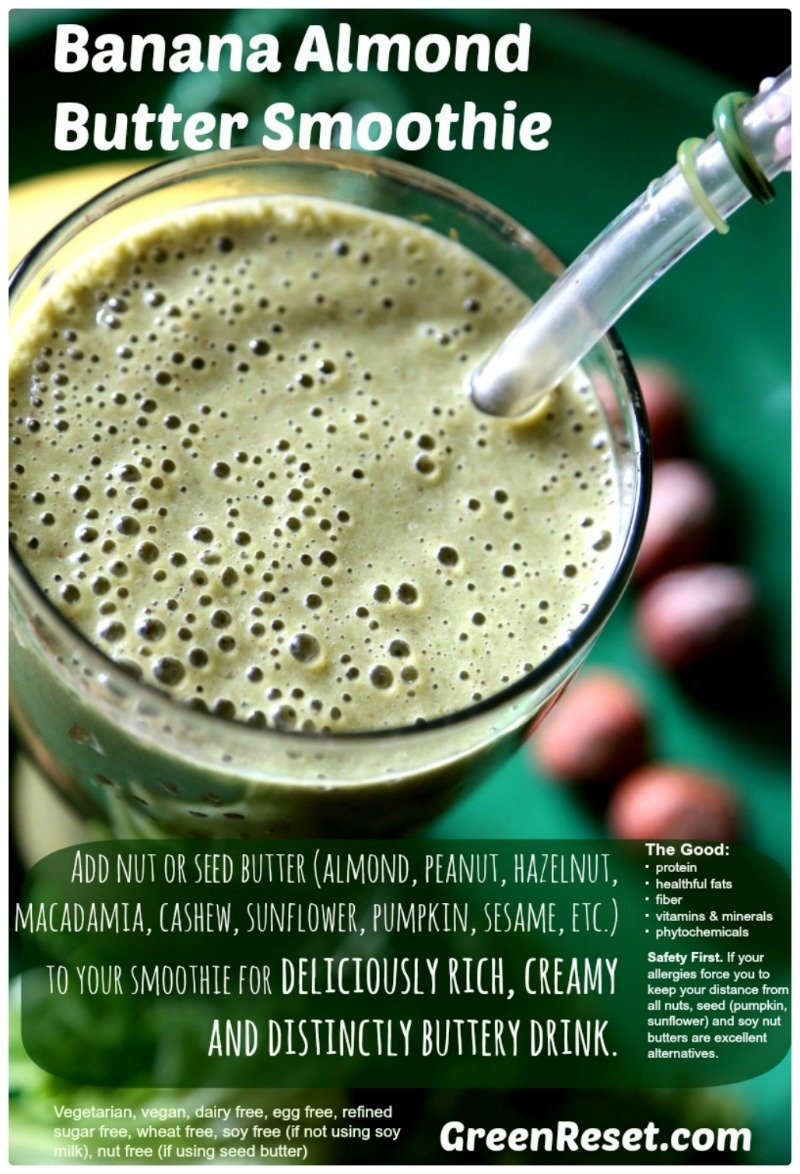
It’s easy. Simply add 2-3 tablespoons of seed or nut butter to your other ingredients and blend! What could be better than a smoothie like this to kick off your morning?
- Vegetarian, vegan, dairy free, egg free, refined sugar free, wheat free, soy free (if not using soy milk)
- Nut free (replace nut butter with 1/2 cup of sunflower, or pumpkin seed butter.)
- Gluten free (use gluten-free oats or quinoa)
- Salt free (don’t add salt and make sure the butter you use doesn’t have any salt added)
- Raw (use raw oats/quinoa)
Variations
To make the smoothie into even more filling meal-replacement drink, add:
- 1/2 cup oats, quinoa, or chia seeds (makes a thicker smoothie)
- 1 tablespoon of ground flax seeds
- 1 cup water, or to desired consistency
If using dry ingredients, blend them with liquid first until smooth. Then add the rest of ingredients and blend on high until smooth and creamy. (High speed blenders may need 2 minutes, less powerful blenders may need a lot more, sometimes 5-10 minutes).
More tips
- Add more liquid if required to thin it out.
- Substitute any of the ingredients for whatever you already have, for example, add berries instead of peaches; add one more banana, and skip other fruit – for a banana only smoothie; add chia or quinoa (cooked or raw), instead of oats.
- If you want a cold smoothie, add frozen fruit (you can freeze your bananas before use), or add ice instead of water.
The Benefits. Nut butters contain a number of important nutrients, including:
- protein
- healthful fats
- calcium (see the note below)!
- fiber
- vitamins and minerals
- phytochemicals (which according to the American Cancer Society may help prevent cancer)
Check the Label. Be sure to check the label before selecting a nut butter. While all nut butters contain around 100 calories per tablespoon, not all nut butters contain healthful ingredients. Many brands contain only ground-up nuts, but some contain added salt and sugar. Some use partially hydrogenated oil—a source of unhealthy trans fats.
Watch the Calories. While nuts are considered to be “nutritional powerhouses,” they’re also high in calories. Therefore, if you eat a lot of nuts or nut butters, cut back in other areas. Don’t let fear of fat keep you away from trying nut butters, however. Eating just two ounces of nuts weekly can lower your risk of heart disease.
Safety First. If your allergies force you to keep your distance from all nuts, seed and soy nut butters are excellent alternatives. Sunflower seed butter is high in heart-healthy poly-unsaturated fats. Soy nut butter (which tastes similar to peanut butter) is higher in protein and lower in fat than the average nut butter. If your nut allergies are severe, ask your doctor to test for potential soy or seed intolerances before trying these options. If you have a family history of nut allergies, play it safe. It’s important to check with your doctor if you or your child has even a minor allergic reaction to nuts. A mild past reaction may indicate a risk of a more severe future reaction. While nut allergies can be a burden, you can prepare your favorite recipes with one of the many nut butter alternatives.
The Surprising Benefits of Almond Butter
Nut butter is a great source of healthy fats, which are important for regulating your energy, mood, and even your weight.
However, some nut butters also deliver a more unexpected benefit: They’re great for your bones!
Let’s take a look at two of the most popular nut butters–almond butter and peanut butter. Between the two, which one should you choose for better bone health?
Almond butter wins hands down in this one. Compared with peanut butter, it contains more calcium, magnesium, manganese and phosphorus, which are all important minerals for building and maintaining strong bones.
Check out the comparison below (per two tablespoons of both almond and peanut butter):
| Mineral |
Almond Butter |
Peanut Butter |
| Calcium |
86.4 mg (8% DV) |
13.8 mg (1% DV) |
| Magnesium |
97 mg (24% DV) |
49.3 mg (12% DV) |
| Manganese |
0.8 mg (38% DV) |
0.5 mg (23% DV) |
| Phosphorus |
167.4 mg (16% DV) |
115 mg (11% DV) |
Plus, if you add calcium fortified almond milk, you’ll get even more of that bone building ingredient!
Making Nut Butters
You can easily make your own nut butters—from a variety of raw and roasted nuts—for a fraction of the cost of store-bought. Once you’ve tried the basic Peanut Butter recipe, your own creativity becomes a main ingredient. Combinations of various nuts and added natural flavorings will produce a range of delicious spreads.
Try these tips and ideas for creating your own, customized nut butters at home:
- Experiment with various combinations of nuts, including almonds, cashews, pecans, walnuts, pistachios, macadamia, or Brazil nuts.
- Add seeds and fruits, like pumpkin or sunflower seeds, raisins, and other dried fruits to the recipe.
- Add sweetness & flavor with maple syrup, vanilla, cocoa, cinnamon, or cardamom.
- Even creamier consistencies can be created with a teaspoon of coconut oil for a subtle tropical flavor, or flaxseed oil for an omega 3 boost.
- Roasting nuts on a baking sheet at 350 degrees for 10-15 minutes will give nut butters a deeper flavor and creamier texture, and release oils more easily in processing. Walnuts will mellow from roasting if a less sharp flavor is desired.
For all my blending recipes – including smoothies, soups, nut butters and milks, I use Vitamix. If you don’t already own a VitaMix, I strongly encourage you to check out what this machine is capable of! For more information about VitaMix you can go directly to the VitaMix website. You may also want to read my post about the Best Blender.
I LOVE my VitaMix and highly recommend investing in one if you are ready to make serious changes to your diet. I have had mine for almost 5 years and use it daily!
If you decide to purchase Vitamix – be sure to use Promotional Code 06-004554 to get free shipping.
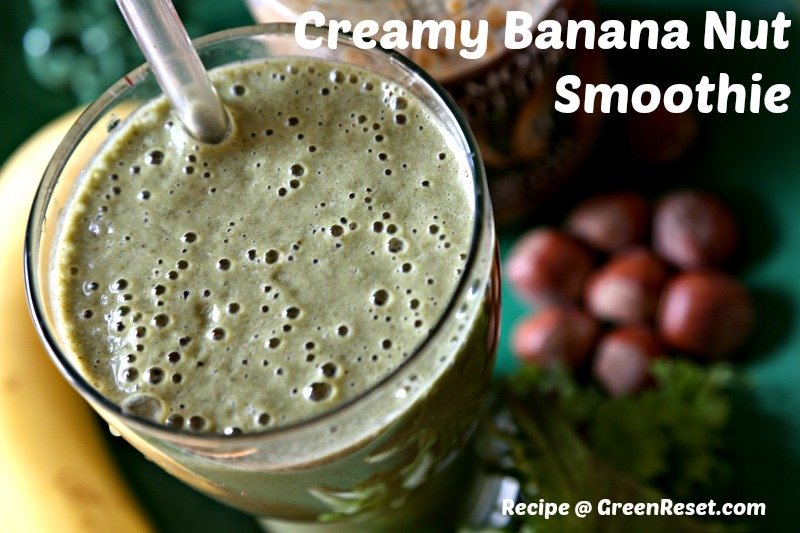
Questions? Comments? Suggestions?
If you have a favorite recipe, why not submit it here in the comment section of this smoothie recipes blog for others to enjoy too!
I also welcome any comments, questions and suggestions. Thanks!
As the summer is ending, I want to welcome all of you back again, hoping to be able to inspire you and maybe challenge you in various ways in the upcoming months.
Although the summer is almost gone, and most of you have probably already forgotten about it, I’m just getting back into the rhythm of my regular work-school-home routine. Most of you have not heard from me the whole summer. My father passed away this summer and I spent a couple of months back home; not working, but doing lots of thinking. It was a really sad time; I had never before experienced death of anyone so close to me. It may sound trite, but the moments like this really make you examine your life, your motives and why you are on this planet.
High Protein Blueberry Smoothie
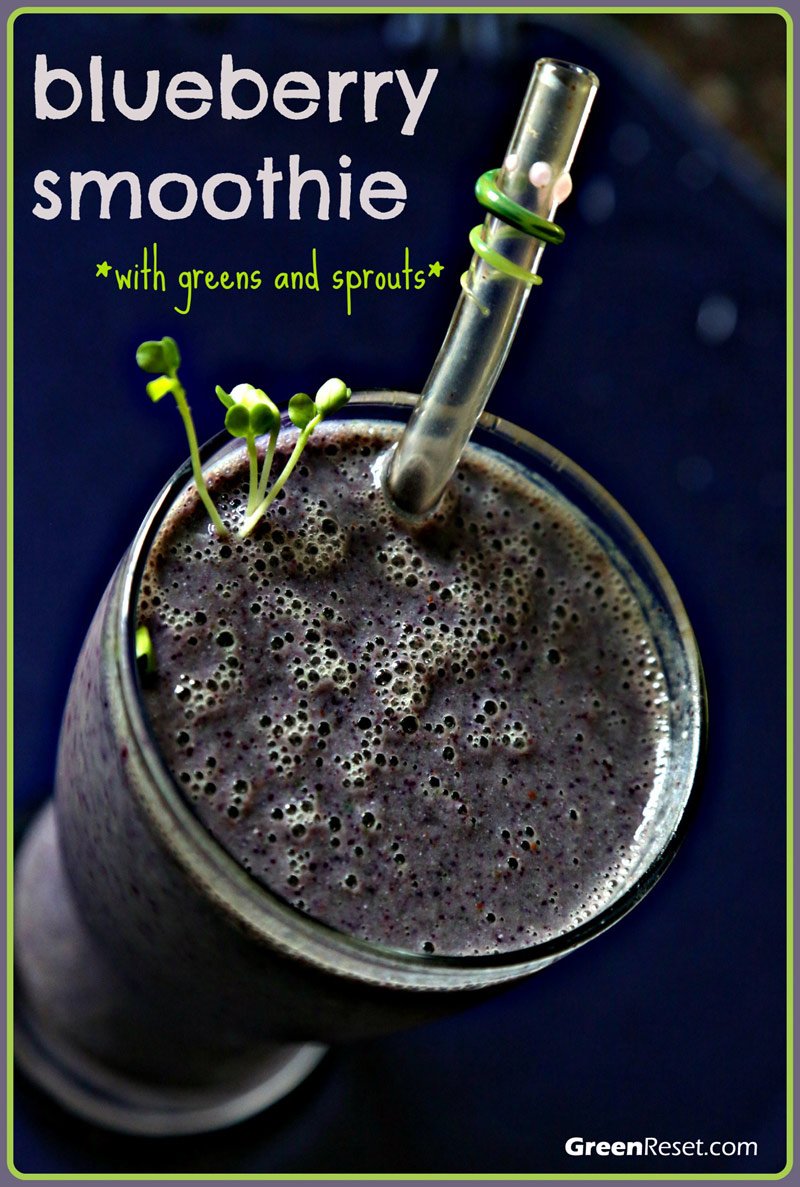
This blueberry smoothie has additional protein added to the mix – I used tofu, but you may use chia seeds or hemp seeds, a tablespoon or two of nut butter, or a handful of nuts. I usually don’t add anything other than fruits and greens to the smoothie, but adding this will make the smoothie more filling.
Ingredients
1 banana
1/2 cup tofu
1 cup wild blueberries
1 cup greens
1 cup sprouts (optional, add more greens if not using sprouts)
1 cup water
Instructions
Blend all ingredients, pour into a glass, sip and smile!
Variations:
* You may substitute tofu with vegan protein powder, 1/cup of chia seeds, or hemp seeds.
(Now, I noticed that soy can elicit extreme reactions in some health-conscious people. If you have concerns about soy or tofu, I encourage you to read or listen to any of the Resources at the end of this post.)
Day’s Menu
Some readers have been asking me for menu suggestions.
Here is a sample day’s menu that is loaded with healthy foods:
Morning/Breakfast: Protein Blueberry Smoothie, Oatmeal (if still hungry)
Lunch/Snack: Curried Carrot Soup (with a side salad or a slice of whole wheat bread)
Dinner: Veggie burger (store bought or home made), potatoes, salad
Dessert: Home-made banana ice-cream
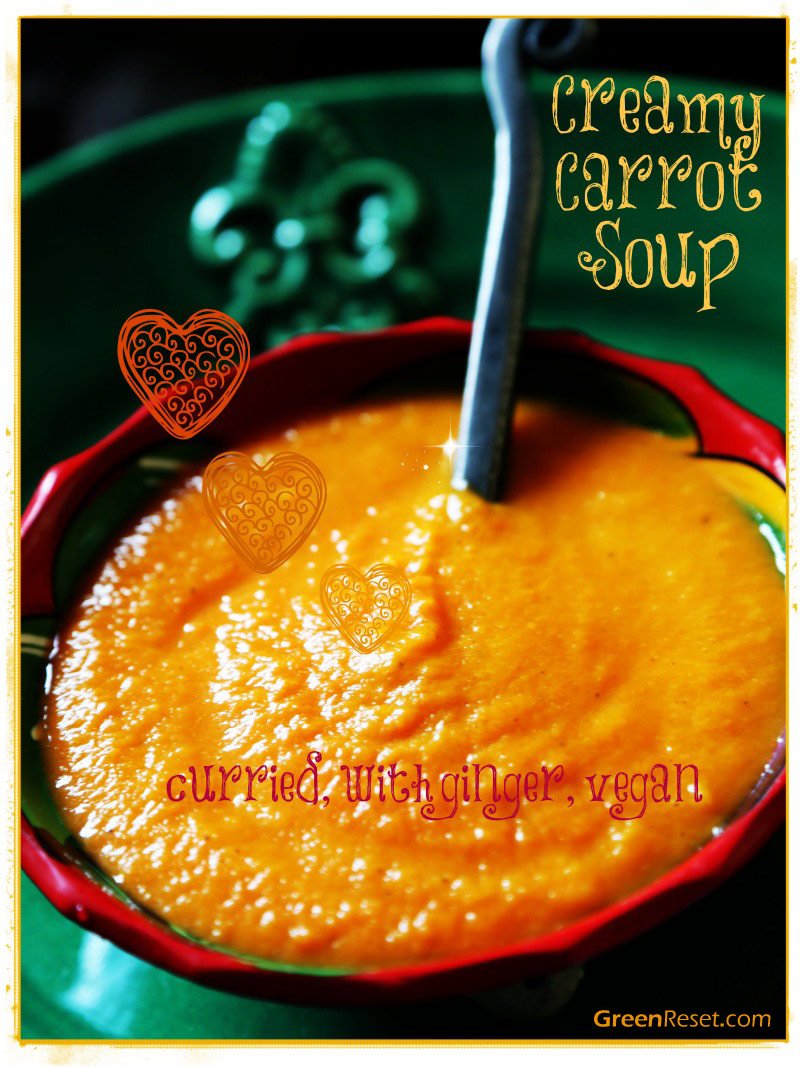
This recipe is uncooked (raw), low-fat, low-calorie, GMO-free, gluten-free, dairy-free, cholesterol free, vegetarian and vegan.
Questions? Comments? Suggestions?
If you have a favorite recipe, why not submit it here in the comment section of this this blog for others to enjoy too!
I also welcome any comments, questions and suggestions. Thanks!
Delightfully bright, this carrot soup recipe is packed with goodness. I like to add freshly made carrot juice, but it’s an extra step (and more cleanup), so feel free to skip it and just add a bit more water or non-dairy milk.
Freshly grated ginger gives this sweet carrot puree an extra kick of flavor and takes up the heat a notch (my 9-year-old didn’t appreciate that, so next time I’ll skip it for a milder taste). Another option is to add a few strips of orange zest. For some crunch, add a garnish of toasted pumpkin seeds, sunflower seeds, or pine nuts.
Creamy Curried Carrot Soup Recipe

Ingredients
- 1 onion, chopped
- 2 teaspoons curry powder
- 2 tablespoons spelt or rice flour
- 4 carrots, tops removed, washed and chopped
- 4 cups water or vegetable stock
- 1 cup carrot juice (juice 2-3 carrots)
- 1 cup non-dairy milk (soymilk, almond milk, etc.)
- 1 tablespoon agave or other sweetener (use less if using sweetened milk)
- a slice of fresh ginger root, grated (optional)
- fresh pepper and salt, to taste
Instructions
- In a large pot, saute the onions with curry powder in 2-3 tablespoons of water for 3-5 minutes, until the onion turns translucid (cover the pot to prevent water from evaporating and onion from burning). Stir in flour, carrots and water or stock. Bring to boil and simmer for 20-30 minutes, until carrots are tender.
- Juice carrots for 1 cup juice. This step is optional. If you'd rather skip juicing, just add a little more stock or milk, or water.
- Using a hand-blender blend the contents of the pot; or if using counter top blender or food processor, transfer the contents into the container and blend well. If using ginger, add it to the mixture and blend well.
- Add carrot juice, non-dairy milk, agave. Season with salt & pepper to taste.
3.1
https://greenreset.com/curried-carrot-soup/
Variations:
* Add a sweet potato instead of 2 carrots.
* Add a few strips of orange zest to the soup when cooking. (Remove the strips of orange zest before blending and discard.)
* Garnish with toasted pumpkin seeds, sunflower seeds, almonds or pine nuts. Or use chopped chives, parsley, or fennel fronds.

This soup is an elegant and tasty accompaniment to any meal. Enjoy!
Special Diets:
Dairy Free
Gluten Free
Vegan
Vegetarian
Fat Free
High Fiber
Questions? Comments? Suggestions?
If you have a favorite recipe, why not submit it here in the comment section of this Green Reset blog for others to enjoy too!
I also welcome any comments, questions and suggestions. Thanks!
Three colorful root vegetables – carrots, beets and jicama – combine to make this delightful, crunchy, and nutritious salad.
Raw beets taste similar to raw carrots in that they’re sweet, juicy, and crisp. Jicama, a Mexican root vegetable that looks like a large, pale, round potato (you can see it on one of the photos below), is crunchy and mild when peeled and eaten raw. If you can’t find jicama, skip it or substitute cubed cucumber in this salad.
This beautiful combination also happens to be extremely rich in antioxidants, making it a terrific choice for preventing a wide variety of diseases. Do your best to find a fresh jicama, as it adds a refreshing taste and crunchy texture to this recipe.
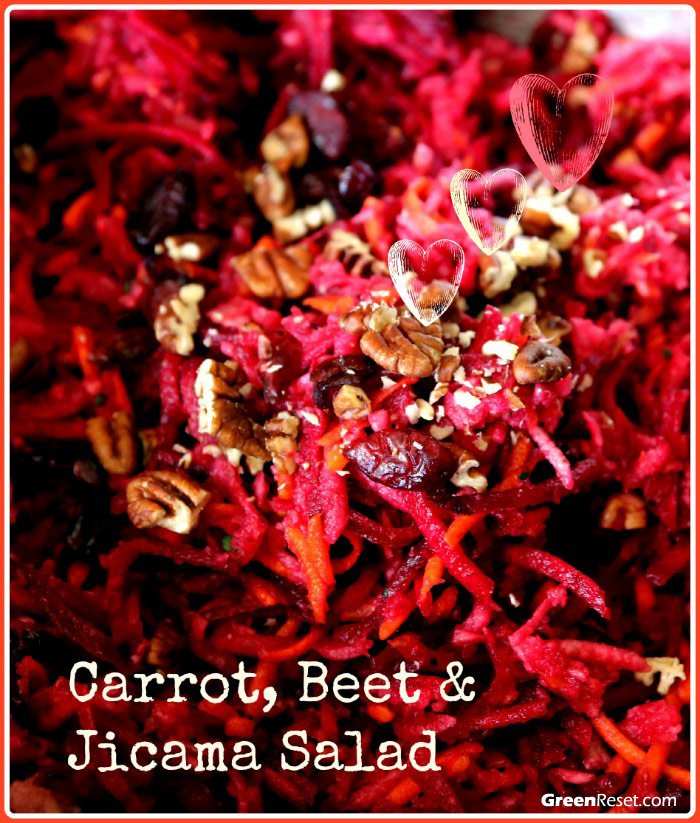
Carrot, Beet, and Jicama Salad
2 medium beets, grated (I use raw, but some people prefer to steam them first)
1 small jicama, peeled and grated, or cut in thin strips
2 carrots, peeled and cut in thin strips or grated
3 tablespoons lemon juice or orange juice, freshly squeezed
2 tablespoons seasoned rice vinegar
2 teaspoons stone-ground mustard
Simply combine shredded red beets, jicama, and carrots with wet ingredients in a large bowl and give it a good toss. Add sea salt, to taste.
Mix juice, vinegar, mustard, and dill. Pour over salad. Toss to mix. Chill before serving if time permits.
If you don’t have a good shredder that can process the beets, jicama, and carrots, into neat, thin strips, you can use a good knife to julienne these vegetables into matchstick-like strips.
1. Place beets in medium bowl along with jicama, avocado, orange, and cilantro.
2. Whisk together orange juice concentrate, lime juice, cumin, and coriander. Whisk in oil. Pour over beet mixture, and toss to mix. Season with salt and pepper, if desired. Sprinkle each serving with toasted pumpkin seeds.
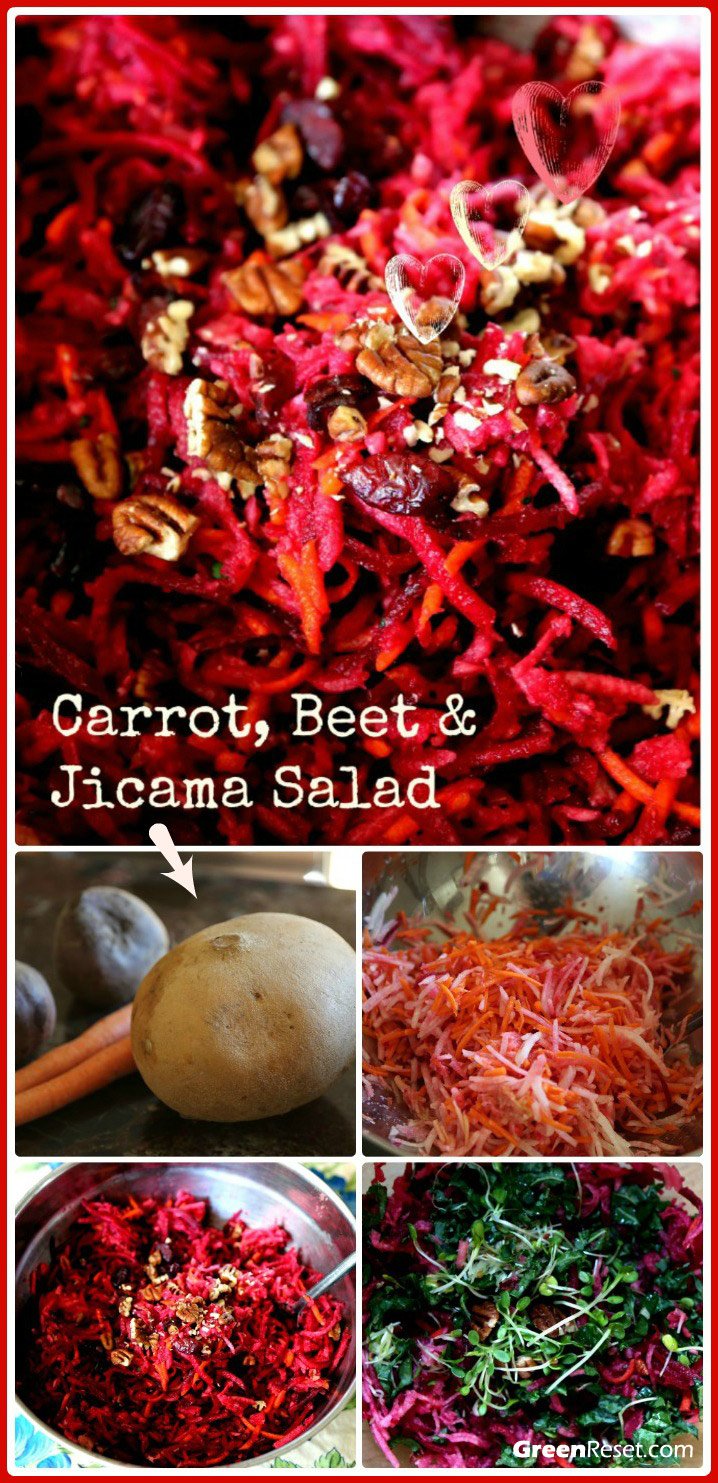
Variations
- Go nuts: I love pecans with this salad, but you can add 1/2 cup of walnuts, or other nuts that you like.
- Sunflower seeds, toasted pumpkin seeds will also be delicious with this salad.
- Add 1/2 cup of dried cranberries or raisins.
- For even more striking colors (and amazing nutrients), add 1 cup of shredded kale and/or 1 cup of sprouts.
- Add a small piece of raw ginger root to the dressing and blend.
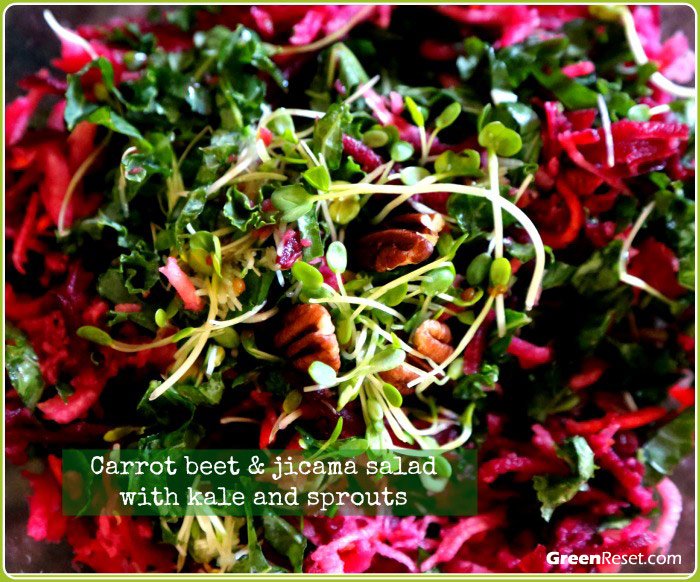
A salad is a perfect accompaniment to any meal. Enjoy!
Questions? Comments? Suggestions?
If you have a favorite recipe, why not submit it here in the comment section of this green smoothie recipes blog for others to enjoy too!
I also welcome any comments, questions and suggestions. Thanks!
This weekend, I was looking for an easy recipe to make a fruit pie. I searched online and in my recipe books, looking at various traditional recipes, but then I came across this no-bake version made with berries, nuts and seeds, chia seed pudding and vanilla.
Since chia seed recipes have been on my radar lately, as well as I was looking for more ways to use my vanilla bean paste from Tahiti, I decided to give it a try.
It’s a quick and easy dessert, as no baking is required! This is nice, especially on a hot summer day (who wants to spend time in hot kitchen!)
No-Bake Berry Chia Pudding Pie
gluten-free, wheat-free, cholesterol-free, soy-free
(recipe inspired by Simple Chia pudding Pie)
This Tart needs time to ‘cook’ in the fridge, so you may start it the night before or in the morning for dinner.
Easy Fruit Tart (No Bake Dessert)
Ingredients
For the crust
-
- 1 cup of pitted dates (use less for less sweet pie)
- 1 cup of nuts or seeds (I used pumpkin seeds for nut-free pie. You can use pecans, walnuts, macadamias, Brazil, sunflower seeds, etc)
- 1/2 cup shredded coconut
- 1/4 teaspoon vanilla bean paste or real Vanilla (the black seeds from a pod)
- a pinch of salt (optional)
-
-
For the filling
- 1 cup mixed berries or berries of your choice
- 1 ripe banana
- 3 teaspoons of Agave nectar or 3 dates (pre-soaked)
- 2 tablespoons of chia seeds
- 1/4 teaspoon real Vanilla
- 1 cup berries for decoration
-
-
Instructions
- For the crust: Soak the dates for 5 minutes. In your blender or food processor (I used my Kitchen Aid for this job), grind the nuts and/or seeds into a flour. Add the remaining ingredients and process until dough starts to form. Press the dough down firmly until it forms a crust on a 8-10 inches baking form (20 cm).
- For the filling: Add all of the ingredients to your blender. Pour the filling over the base and spread evenly. Decorate with berries and other toppings (nuts, shredded chocolate pieces, etc.)
- Keep in the fridge to chill a couple of hours before serving or overnight.
3.1
https://greenreset.com/fruit-tart/
I only had frozen berries and some fresh strawberries, but it will also be wonderful with fresh fruit.
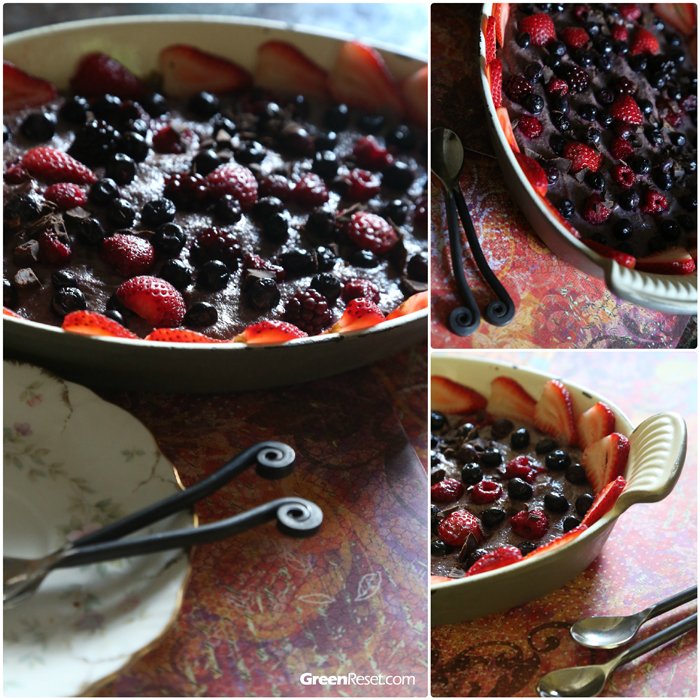
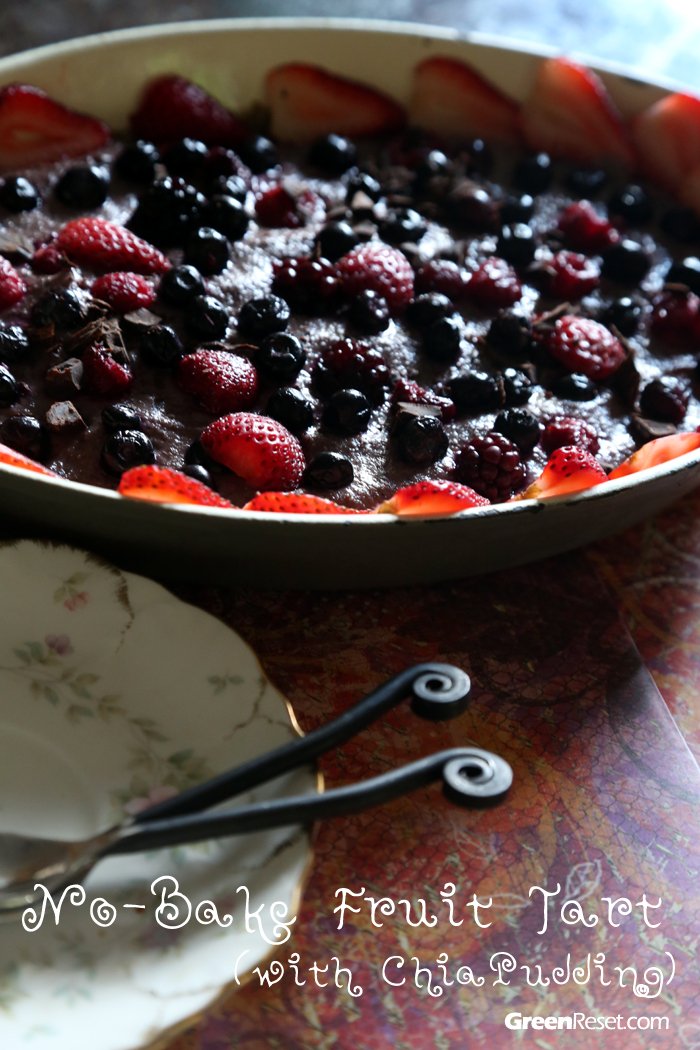
Variation of the filling
You can skip the banana and add 1 cup tofu to the filling, plus one orange (peeled) or some orange juice. Or add both banana and tofu.
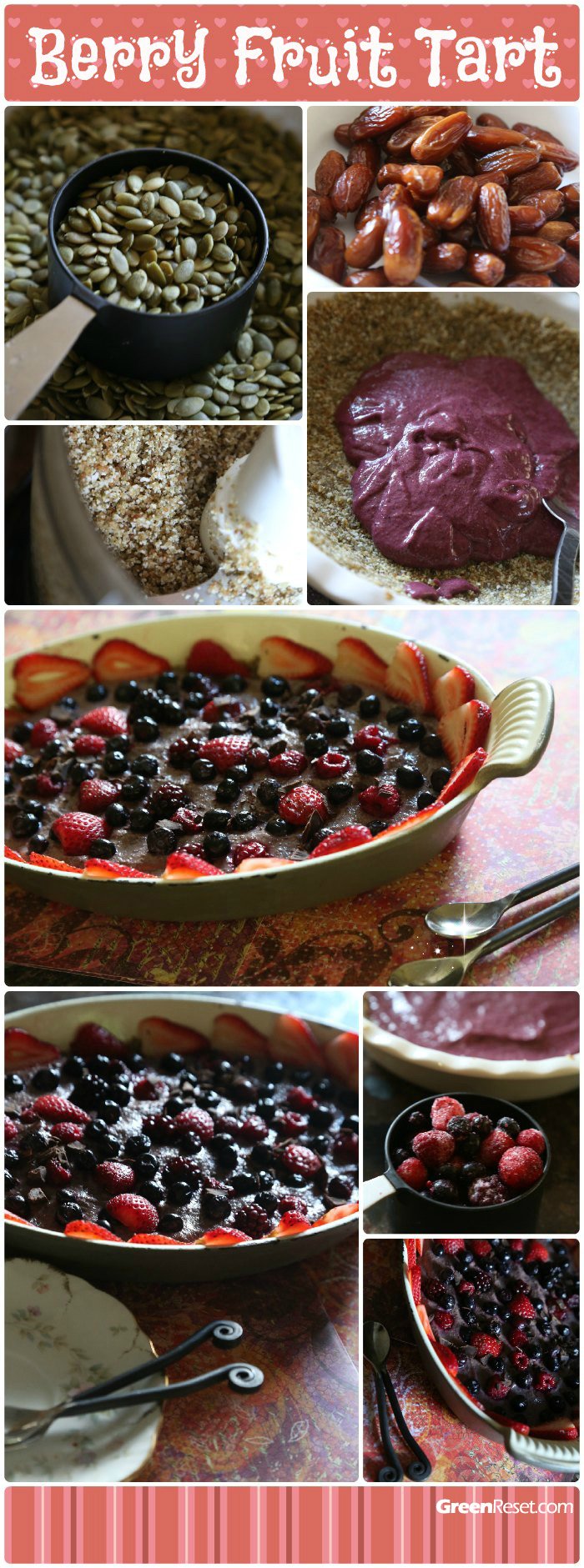
Questions? Comments? Suggestions?
If you have a favorite recipe, why not submit it here in the comment section of this green smoothie recipes blog for others to enjoy too!
I also welcome any comments, questions and suggestions. Thanks!













